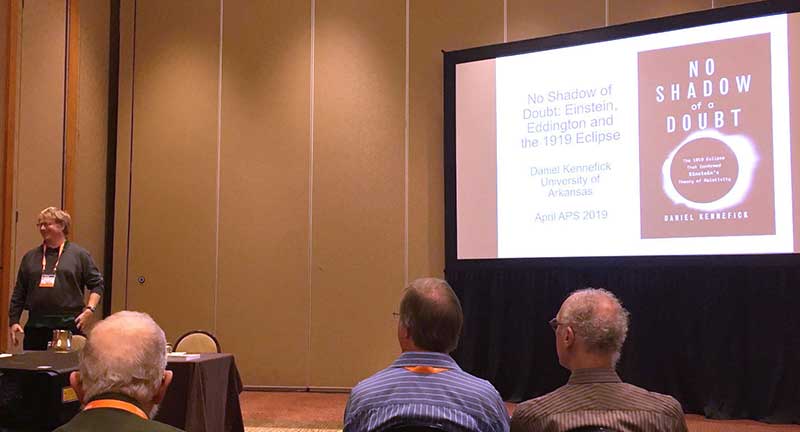“Centennial of the Eddington Eclipse Expedition,” (DGRAV co-sponsor)
By Donald Salisbury
Over a hundred conference participants gathered almost exactly one hundred years after the date in March 1919 when two English expeditions embarked from Liverpool to test Einstein's theory during the solar eclipse of May 29. The positive results reported by Arthur Stanley Eddington and Sir Frank Watson Dyson at a combined London meeting of the Royal Society and the Royal Astronomical Society on November 6, 1919, as reported in the New York Times with the headline LIGHTS ALL ASKEW IN THE HEAVENS, brought Einstein instant worldwide fame. As the first presenter, Daniel Kennefick’s title was “No Shadow of a doubt: Eddington, Einstein and the 1919 Eclipse”. He had recently thoroughly researched the expeditions of Dyson to Sobral, Brazil and Eddington to the island of Principe and recently published his studies in the book No Shadow of a Doubt. The 1919 Eclipse That Confirmed Einstein's Theory of Relativity. Looking at correspondence between Dyson and Eddington he was able to expose as a myth the claim that since Eddington believed in the correctness of Einstein's theory he had made the data conform with general relativity. It is indeed true that the data from the Greenwich astrographic lens taken in Brazil was excluded, but it was the skeptic Dyson who made this decision without any input from Eddington. The data, which seemed to indicate a deflection of starlight passing the rim of the sun of roughly twice the value predicted by Einstein, was discounted because of probable errors in analyzing the expansion of the photographic plates. The four-inch telescopic data yielded 1.98” compared to Einstein's prediction of 1.75”. Because of the partial cloud cover in Principe only five stars were imaged as opposed to the twelve in Sobral, and Kennefick argues that Eddington was justified in assigning a larger uncertainty of 0.30” to the quoted result of 1.61”.
Donald Bruns’ spoke on “Repeating the Experiment that Made Einstein Famous”. He reported on a remarkably successful optical measurement of starlight deflection that he performed in Wyoming during the August 21, 2017, solar eclipse. The experiment was carefully planned over many months – with the use of optimal amateur astronomical equipment and analysis software. The site selection itself was not accidentally fortuitous. He chose an altitude that reduced atmospheric turbulence and offered high confidence in good seeing conditions. The chief innovation was the use of a CCD camera that permitted much shorter exposure time and reliance on the 2016 Gaia data release both to calibrate the plate scale and to determine the stellar image displacements during the eclipse. His reported value was precisely 1.75” with an extraordinary uncertainty in the deflection of only 0.05”. This is by far the best earth-based optical measurement. Radio telescope quasar measurements are of course now able to confirm Einstein's theory with a precision of 0.01%. This work was considered so important from an historical perspective that it was published in Classical and Quantum Gravity.
Jeffrey Crelinsten’s title was “Einstein’s Jury: Trial by Telescope. He is a science writer who has analyzed the early resistance of US astronomers to Einstein's theory in his text Einstein's Jury. The Race to Test Relativity. He offered a complementary perspective on historical eclipse observations. A central player in his saga was the astronomer William Wallace Campbell who was based at the Lick Observatory on Mount Hamilton in California. He had planned to observe the August 21, 1914, full eclipse in Russia, but although his equipment did reach his intended site he was forced to abandon his trip because of the outbreak of World War I. This was doubly disappointing since he was then forced to employ inferior equipment in observations he actually undertook in Goldendale Washington in June, 1916. He and his assistant were further hampered by their inability to obtain timely comparison plates that would enable them to compute the stellar deflections. They never did successfully analyze and publish their results from 1916 though rumors occasionally surfaced, even after 1919, that their observations conflicted with Einstein's prediction. Finally in 1922 seven different attempts were made to measure light deflection during the 1922 total eclipse in Australia. Campbell's group made observations on the west coast that were finally announced in 1924 as being in accord with Einstein.

Daniel Kennfick [Photo by Donald Salisbury]
The articles in this issue represent the views of their authors and are not necessarily those of the Forum or APS.
